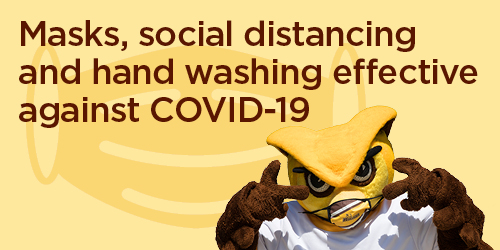Wear a mask, please
Wear a mask, please

Throughout the summer, a period in which the rate of COVID-19 infection exploded across the U.S., medical experts have consistently agreed that if we do just a few things we can dramatically reduce the spread of disease.
In fact, since the beginning of the outbreak, those recommendations haven’t changed: maintain social distancing of six feet or more, wash hands frequently and wear a mask!
Empirical data shows that wearing a surgical style or cloth mask around others, especially when people can’t stay at least six feet apart, reduces the risk of spreading the novel coronavirus and the potentially deadly disease COVID-19.
Rowan Medicine’s Dr. Judith Lightfoot, an infectious disease specialist, said recently that the guidelines haven’t changed because, frankly, they work.
“The primary purpose of wearing a mask is simple,” she said. “I protect you. You protect me. Many of us could be asymptomatic and harboring virus and not know it. Also, once exposed, it may take a few days before clinical symptoms are recognized so a simple, proven precaution is wearing a mask.”
Why masks work
Coronavirus can spread through tiny droplets when infected people exhale, especially when they sneeze, cough, talk, shout or sing, and healthy people can become infected if they breathe those droplets in. The physical barrier created by a mask contains these respiratory droplets, preventing them from spreading.
In fact, the evidence that wearing a mask helps prevent the spread of disease is so strong that the Journal of the American Medical Association proclaimed July 14 that “the time is now” for universal mask wearing.
Which isn’t to say any face covering is good. Experts agree that hospital grade N95 masks work best for personal protection but layered cloth and surgical-style masks also work well.
Research from the University of Colorado indicates that mask material matters, with thick more effective than thin and layered cloth masks, versus one thin sheet, providing greater defense against viral spread. The UC Boulder research indicates that “talking emits far more respiratory particles than breathing, and singing or shouting emits more particles than talking.”
And forget about bandanas. A study from Duke University, published Aug. 7 in the journal ScienceAdvances, found that bandanas and simple neck gaiters are not effective barriers and should not be worn to prevent spread of the virus.
When should I wear a mask?
The simple answer, Dr. Lightfoot said, is everywhere people converge but can’t socially distance.
“The basic point is that when two or more people are in close proximity, if they have the protective barrier of a basic cloth or surgical mask there is a better yield of protection,” she said.
Dr. Lightfoot said that on campus, especially in public areas of residence halls, classrooms, lab space and anywhere else one can’t socially distance, wearing a mask remains imperative.
She noted that though incidence of COVID-19 has been low in the Rowan community, all members of it – students, faculty, staff and administrators – must be vigilant to protect against an outbreak.
Like other experts, Dr. Lightfoot noted that before donning a mask it is imperative to wash one’s hands with soap and water (or an alcohol-based sanitizer that has dried), to wash hands upon entering a building and to sanitize door handles and other frequently touched areas.
As for masking and social distancing outdoors, she said, “the simple rule of thumb is remaining at least six feet apart. I don’t think you need a mask when riding a bike but when you’re standing around or waiting to get in somewhere, keep in mind the six-foot guideline. And have your mask on.”
For more information, please see Rowan’s mask wearing guidelines.